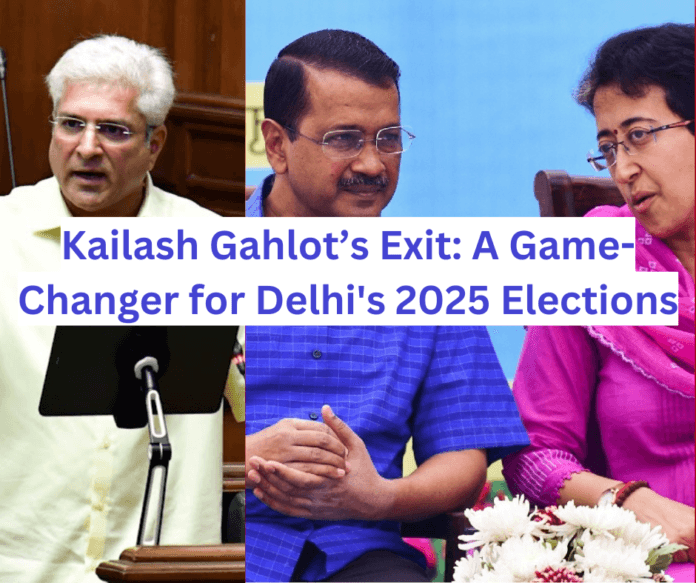Kailash Gahlot Resignation: The Aam Aadmi Party (AAP) minister known for his roles in Delhi’s transport and revenue departments, made headlines recently by resigning from his post just ahead of the Delhi assembly elections. This shocking resignation has stirred political debates, leading to a war of words between AAP and the Bharatiya Janata Party (BJP), with accusations flying from all sides. Gahlot’s exit has raised questions about internal party politics, and the unfolding drama is likely to influence the political landscape of Delhi as the election date approaches.
While Gahlot himself has stated that his resignation is due to “personal reasons,” his departure has been met with strong reactions from both AAP and BJP. The ruling AAP party quickly accused the BJP of orchestrating a political conspiracy aimed at weakening the party’s chances in the elections. On the other hand, BJP leaders have praised Gahlot for what they term a “courageous step,” dismissing the conspiracy claims and instead framing it as a personal choice for better political future.
What Triggered Kailash Gahlot Resignation?
The exact reason behind Gahlot’s resignation remains murky, as it has been enveloped in a cloud of political intrigue. AAP’s leadership has publicly expressed their belief that the resignation is part of a larger strategy by BJP to discredit the party ahead of elections. The AAP spokespersons have suggested that Gahlot’s exit is tied to BJP’s “dirty politics” and their efforts to destabilize the Delhi government. They also alleged that Gahlot was coerced into stepping down due to pressure from BJP, which has been actively trying to weaken AAP’s stronghold in the capital.
On the other hand, BJP has dismissed these accusations, calling Gahlot’s decision a personal one, unrelated to any external influence. The party has even praised him for showing the courage to break away from a party that, according to BJP leaders, is mired in corruption and mismanagement. BJP has used this resignation to push their narrative of AAP’s internal struggles, hoping to garner voter support by showcasing the discord within the ruling party
The Political Fallout of Gahlot’s Resignation
Kailash Gahlot’s resignation is set to have significant ramifications for both AAP and BJP in the lead-up to the Delhi elections. The resignation has already become a key issue in the political discourse, with both parties attempting to use it to their advantage. For AAP, the timing is crucial, as they face accusations of instability within their leadership ranks. Losing a high-profile minister just before the elections raises doubts about their internal cohesion, which could potentially affect voter confidence.
For BJP, this resignation is seen as a potential opportunity to strengthen their electoral prospects. The BJP is expected to highlight the episode as a sign of discontent within AAP, painting the party as one that cannot maintain loyalty among its own leaders. By positioning this as part of a broader failure within AAP’s governance, BJP aims to galvanize support among voters disillusioned with AAP’s leadership
A Closer Look at Political Defections in India
The recent resignation of Kailash Gahlot is not an isolated event in Indian politics. Political defections have long been a part of the political landscape, particularly during election cycles. Leaders switching parties, resigning from key positions, or being coerced into stepping down is a common strategy used by parties to alter the balance of power. Gahlot’s resignation adds to this growing list of high-profile defections, raising questions about the ethics and motivations behind such moves.
Defections often signal political instability and can cause ripples in the electoral strategies of both ruling and opposition parties. Whether it’s the promise of immunity from legal cases or offers of a better political future, these defections play a pivotal role in shaping voter perceptions. In Gahlot’s case, his resignation has drawn attention to AAP’s leadership style and prompted the public to question whether internal dissent is more widespread than publicly acknowledged
What’s Next for Kailash Gahlot?
As the political storm surrounding his resignation brews, all eyes are on Kailash Gahlot to see what his next steps will be. Will he join the BJP, or will he step out of the political limelight entirely? Many analysts speculate that Gahlot could be courted by BJP, which would provide them with a significant political advantage as they prepare for the elections. On the other hand, Gahlot could choose to remain independent, aligning with his personal beliefs rather than party politics.
In the meantime, AAP faces the difficult task of managing the fallout from Gahlot’s resignation. Party leaders are working hard to maintain morale within their ranks and counter the narrative that suggests internal discord. The party’s ability to navigate this challenge will be key to their success in the upcoming elections. However, the controversy surrounding Gahlot’s departure will likely remain a focal point throughout the campaign.
The Bigger Picture: Delhi’s Political Future
As the current tenure of 7th Delhi Assembly is scheduled to end on 15 February 2025, and it heads into another contentious election, the resignation of Kailash Gahlot highlights the increasingly polarized nature of Indian politics. The episode sheds light on the power plays at work behind the scenes, where party loyalty is often tested, and leaders face pressure to choose sides. Both AAP and BJP are now locked in a battle not only for votes but for political legitimacy.
With elections just around the corner, the ramifications of Gahlot’s resignation will likely continue to unfold, influencing public opinion and voter behavior. For AAP, this resignation may serve as a reminder of the challenges of maintaining unity in a highly competitive political environment. For BJP, it’s an opportunity to capitalize on the turmoil within their rival’s ranks, hoping to sway undecided voters and strengthen their electoral base




